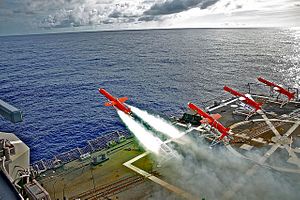A new study by the Center for Strategic and Budgetary Assessments (CSBA) tries to sketch out the future of naval warfare and how it is impacted by the growing dissemination of precision-guided weapons.
Andrew Krepinevich, author of the study titled Maritime Competition In A Mature Precision-Strike Regime, concludes that the advent of long-range sensors and strike capabilities will impose severe restrictions on the freedom of maneuver of surface naval forces. He compares it to the restrictions imposed on surface naval forces operating in the Mediterranean during World War II.
Additionally, he points out that precision-guided warfare has slowly spread among U.S. competitors across the globe and, as a consequence, can no longer be counted on as providing U.S. forces with the decisive edge to achieve victory in combat (see: “The End of the American Way of War”).
However, given the many unknown variables (e.g., the future role of autonomous and directed energy weapons, advances in artificial intelligence, the impact of cyberwar et.), the author is cautious to predict the precise nature of future naval warfare and merely sees this publication as the “beginning of the conversation” on this subject – a “Mature Maritime Precision-Strike Regime 1.0” – according to Krepinevich.
“The broad advance of military capabilities greatly increases the uncertainty entailed in describing the salient characteristics of a mature maritime precision-strike regime,” Krepinevich notes. He also points out that analyses are further limited by a lack of data:
It has been roughly seventy years since two major maritime powers fought each other. In that time the advances in maritime capabilities have been dramatic. Yet the data on the relative value of these new capabilities are meager, culled from minor conflicts that may stimulate as many false conclusions as useful insights.
This corresponds to what I have been arguing for a while now (see: “‘The Fog of Peace’: Why We Are Not Able To Predict Military Power”): trying to ascertain how future conflicts will be fought in peacetime is darn difficult no matter how good your analysis is. Additionally, he states:
As several prospective key competitors—India, Iran, and Japan, in particular—have yet to move aggressively toward fielding the forces that would characterize a mature maritime precision-strike regime, it seems ill-advised to predict what path they may pursue, let alone the ultimate outcome.
The author does point out some of the characteristics of a future “Mature Maritime Precision-Strike Regime” likely to emerge over the next few decades:
There will be different classes of maritime powers. Modest maritime powers will be able to strike fixed targets in their littoral region, whereas a smaller number will have the ability to strike fixed targets at extended ranges, defined as beyond the littoral and perhaps out to a 1,000 nautical miles (nm) or more. (…)
In this environment, attempting to operate surface warships and merchant ships in the enemy’s littoral regions, at least early in a conflict, will likely be prohibitively costly for even the most formidable maritime power.(…)
In such a wartime environment, a surface fleet may spend most of its time operating outside the enemy’s A2/AD maritime “bastions”2 (and perhaps no man’s land as well), conducting periodic short-duration dashes inside the enemy’s A2/ AD perimeter to launch strikes and execute other missions.(…)
Thus although today aircraft carriers possess the U.S. fleet’s greatest combat potential, unless they can project that potential over much greater ranges than is currently possible, they will run a high risk of detection and damage or destruction in a mature maritime precision-strike regime.(…)
What will likely be plentiful are advanced sea mines. Moreover, over time it seems increasingly likely that the distinction between “smart” mines and UUVs will blur, making mines even more formidable. (…)
The undersea domain is almost certain to play an increasingly important role in a mature maritime precision-strike regime for several reasons. First, submarines (especially nuclear-powered submarines) are likely to be one of the few naval assets (in addition to extended-range missiles and long-range carrier aircraft) capable of operating at acceptable risk in the maritime no man’s land and penetrating the enemy’s A2/AD defenses. (…)
Given all of this, how could the United States military go about restoring maritime freedom of maneuver? The report provides four operational concepts that might do the trick:
- Winning the “scouting campaign,” in part by introducing attractive false targets, making real targets less detectable (such as through stealth and curtailing electronic emissions), degrading enemy communications, and injecting false information into the enemy’s battle network.
- Depleting the enemy’s long-range strike systems (…).
- Drawing the enemy out from his maritime bastion through, for example, distant blockade, to compel him to seek a quick resolution to the conflict.
- Engaging in peripheral campaigns (e.g., physically seizing key areas outside the immediate area of competition, such as sources of key resources for the enemy).
The U.S. Navy’s new maritime strategy (see: “The United States’ New Maritime Strategy: A Quick Look”) and the service’s new surface warfare concept (see: “The US Navy’s New Surface Warfare Strategy: ‘Distributed Lethality’”) are a direct response to the slowly emerging characteristics of mature maritime precision-strike regimes.

































